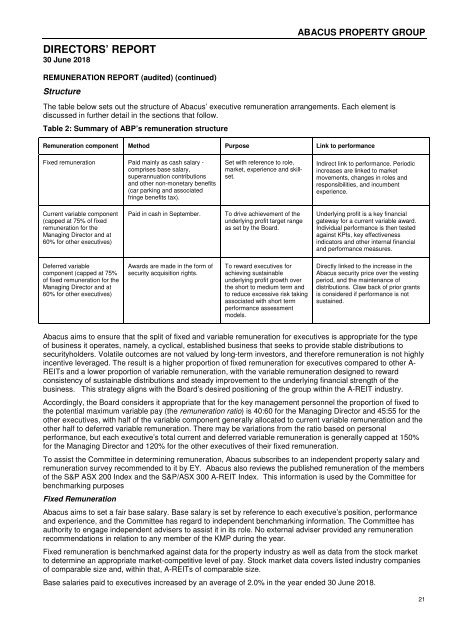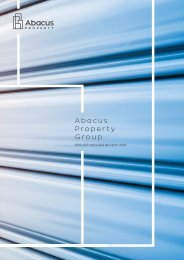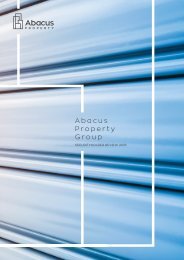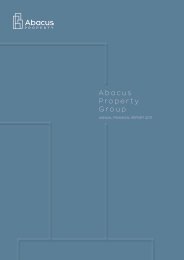Abacus Property Group – Annual Financial Report 2018
Create successful ePaper yourself
Turn your PDF publications into a flip-book with our unique Google optimized e-Paper software.
DIRECTORS’ REPORT<br />
30 June <strong>2018</strong><br />
ABACUS PROPERTY GROUP<br />
REMUNERATION REPORT (audited) (continued)<br />
Structure<br />
The table below sets out the structure of <strong>Abacus</strong>’ executive remuneration arrangements. Each element is<br />
discussed in further detail in the sections that follow.<br />
Table 2: Summary of ABP’s remuneration structure<br />
Remuneration component Method Purpose Link to performance<br />
Fixed remuneration Paid mainly as cash salary -<br />
comprises base salary,<br />
superannuation contributions<br />
and other non-monetary benefits<br />
(car parking and associated<br />
fringe benefits tax).<br />
Set with reference to role,<br />
market, experience and skillset.<br />
Indirect link to performance. Periodic<br />
increases are linked to market<br />
movements, changes in roles and<br />
responsibilities, and incumbent<br />
experience.<br />
Current variable component<br />
(capped at 75% of fixed<br />
remuneration for the<br />
Managing Director and at<br />
60% for other executives)<br />
Paid in cash in September.<br />
To drive achievement of the<br />
underlying profit target range<br />
as set by the Board.<br />
Underlying profit is a key financial<br />
gateway for a current variable award.<br />
Individual performance is then tested<br />
against KPIs, key effectiveness<br />
indicators and other internal financial<br />
and performance measures.<br />
Deferred variable<br />
component (capped at 75%<br />
of fixed remuneration for the<br />
Managing Director and at<br />
60% for other executives)<br />
Awards are made in the form of<br />
security acquisition rights.<br />
To reward executives for<br />
achieving sustainable<br />
underlying profit growth over<br />
the short to medium term and<br />
to reduce excessive risk taking<br />
associated with short term<br />
performance assessment<br />
models.<br />
Directly linked to the increase in the<br />
<strong>Abacus</strong> security price over the vesting<br />
period, and the maintenance of<br />
distributions. Claw back of prior grants<br />
is considered if performance is not<br />
sustained.<br />
<strong>Abacus</strong> aims to ensure that the split of fixed and variable remuneration for executives is appropriate for the type<br />
of business it operates, namely, a cyclical, established business that seeks to provide stable distributions to<br />
securityholders. Volatile outcomes are not valued by long-term investors, and therefore remuneration is not highly<br />
incentive leveraged. The result is a higher proportion of fixed remuneration for executives compared to other A-<br />
REITs and a lower proportion of variable remuneration, with the variable remuneration designed to reward<br />
consistency of sustainable distributions and steady improvement to the underlying financial strength of the<br />
business. This strategy aligns with the Board’s desired positioning of the group within the A-REIT industry.<br />
Accordingly, the Board considers it appropriate that for the key management personnel the proportion of fixed to<br />
the potential maximum variable pay (the remuneration ratio) is 40:60 for the Managing Director and 45:55 for the<br />
other executives, with half of the variable component generally allocated to current variable remuneration and the<br />
other half to deferred variable remuneration. There may be variations from the ratio based on personal<br />
performance, but each executive’s total current and deferred variable remuneration is generally capped at 150%<br />
for the Managing Director and 120% for the other executives of their fixed remuneration.<br />
To assist the Committee in determining remuneration, <strong>Abacus</strong> subscribes to an independent property salary and<br />
remuneration survey recommended to it by EY. <strong>Abacus</strong> also reviews the published remuneration of the members<br />
of the S&P ASX 200 Index and the S&P/ASX 300 A-REIT Index. This information is used by the Committee for<br />
benchmarking purposes<br />
Fixed Remuneration<br />
<strong>Abacus</strong> aims to set a fair base salary. Base salary is set by reference to each executive’s position, performance<br />
and experience, and the Committee has regard to independent benchmarking information. The Committee has<br />
authority to engage independent advisers to assist it in its role. No external adviser provided any remuneration<br />
recommendations in relation to any member of the KMP during the year.<br />
Fixed remuneration is benchmarked against data for the property industry as well as data from the stock market<br />
to determine an appropriate market-competitive level of pay. Stock market data covers listed industry companies<br />
of comparable size and, within that, A-REITs of comparable size.<br />
Base salaries paid to executives increased by an average of 2.0% in the year ended 30 June <strong>2018</strong>.<br />
21











